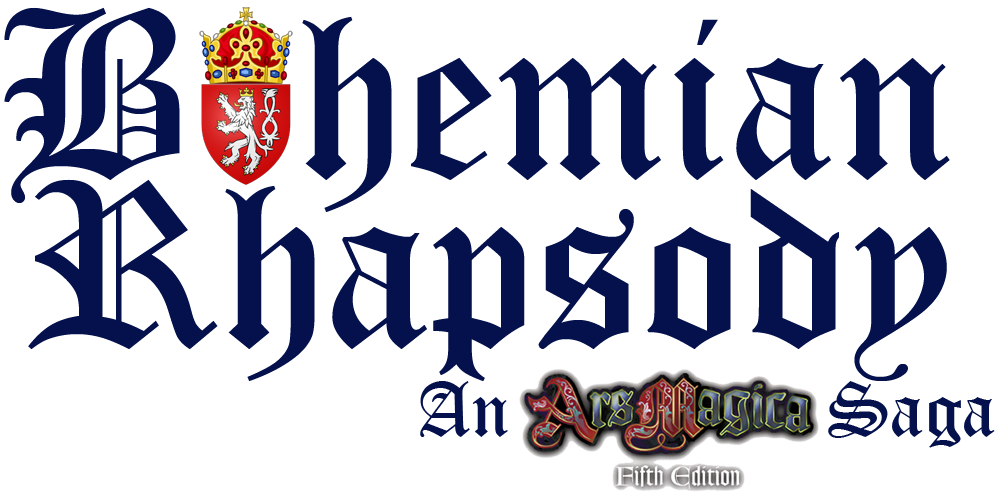 |
The standard for medieval money in Ars Magica is the Mythic Pound (Covenants, page 56). The Mythic Pound allows players to track their wealth and expenses in a simple single currency. The currency is Mythic because it is the standard currency for Mythic Europe, and also in the sense that it is a convenient fiction. Historical medieval currencies varied widely in terms of value, regions of circulation, and usage in trade. Some currencies were favored for trade. English coins, for example, were so consistent in their sterling quality (92.5% silver by weight) that they were used in trade as far away as Italy and Spain. Others were not so favored, and were only used in the regions in which they were minted. Some coins, like English coins, remained consistent in the content of precious metal over many decades. Others suffered debasement from time to time, as the minting authority desired to extract some short-term profit from their coinage, at the expense of its long-term value. The complexity of historical coinage and the various social, economic, and political factors associated with it can seem daunting to Ars Magica players, which is why the Mythic Pound exists. However, by ignoring these complexities entirely, players may miss some story opportunities, and other stories may be deprived of flavor and depth that monetary detail might add. For the Bohemian Rhapsody Saga, there are a few ways to add some flavor and depth to the element of money in stories, without adding a burden of detail that would require a team of accountants just to keep track of everything. First, consider common medieval practices involving money. Nearly all medieval money was ultimately based on the commodity value of a precious metal, such as silver or gold. Although gold coins circulate in Sicily and southern Italy throughout the 13th century, and begin to be minted in northern Italy after 1250 AD, silver is the common currency in Mythic Europe. Prior to the 12th century, the vast majority of silver in the known world came from mines in Central Asia. Those mines began to run out in the early 12th century, however, and a "famine" of silver affected the known world for several decades. In 1168 AD, however, miners discover silver in massive quantities near Freiburg in Germany, and the Freiburg mines become the pre-eminent source of silver in the world. Mines in Tuscany and Sardinia begin to produce quantities of silver about the same time, and from that time Europe becomes the major source of silver for the entire known world. Subsequent discoveries at Jihlava in Bohemia sustain this status throughout the 13th century. Gold, however, primarily comes from outside Europe. Sub-Saharan Africa is the major source of gold in the known world throughout the 13th century. A steady trade between northern Africa and southern Europe begins in the 13th century, trading European silver for African gold. As a result, by the middle of the 13th century, gold is available in sufficient quantity in northern Italy for Florence and Genoa to begin minting gold coins. Other mints soon copy the florin, as the Florentine coin is known, and this becomes the standard for gold coins in Europe. Despite the diversity of historical minting practices, there were some common elements. Most monetary structures are based on a nominal "pound" of silver, which is composed of some number of silver "pennies." We can take advantage of this to form a standard for Mythic Europe as a whole. The Mythic Penny will be the basic component of the Mythic Pound. For simplicity, the historical English standard of nearly pure, sterling silver is used for the Mythic Penny. Twelve Mythic Pennies make one Mythic Shilling, and twenty Mythic Shillings make one Mythic Pound: 240 Mythic Pennies in all. A Mythic Pound of money is nominally equal to the value of one pound of pure silver. Of course, penny, shilling, and pound are English names for money. Different cultures in Mythic Europe have different names for the same concepts. The common abbreviation for a penny is d. for denier or denari, even in England or Germany, and pounds are commonly abbreviated L. The table below lists the names of coins in various Mythic medieval languages: |
||||||||||||||||||||||||||||||
|
||||||||||||||||||||||||||||||
Astute readers may note that the values of historical coins with these names did not in fact always equal the values given in the table above. The Venetian grosso, for example, could be worth anywhere from 26 to 48 denarii, depending on the year. And there never was a French coin named "sou" although that term was frequently used as a measure of value. However, in the simplified monetary system of Mythic Europe, we can use the standard values as listed above, and even pretend that the French call a large silver coin a "sou" (pl. sous). Larger silver coins become more common as the 13th century progresses and trade increases. Although historical values for such coins varied, for Mythic Europe we can set their value uniformly as noted above, with each large silver coin being worth the value of twelve smaller silver pennies. If desired, gold coins worth one Mythic Pound may be minted in your Saga (the florin, for example, historically was created to equal the monetary value of one pound of silver coinage). Assuming a standard in Mythic Europe that one pound of gold equals the value of ten pounds of silver, a gold coin worth one pound of silver would thus contain 1/10th of a pound of gold. Such a coin could be called a pound or lira, if desired, or the names of historical gold coins such as the florin, genovino, or noble could be used. Historically, gold coins were primarily used for international trade, as the value of individual coins was so large that they were impractical for common use (imagine carrying around a wallet of thousand-dollar bills, and trying to buy anything at a store). Ingots of precious metal are also used in trade, especially where gold coins are not available. Because large quantities of coins are unwieldy, wealthy travellers sometimes carry ingots on longer journeys, exchanging some of them for local coins in each region as they arrive. Such exchanges are always slightly unfavorable, as the mint returns slightly less in coin than the value of the silver received. This covers the cost of minting coins and some amount of profit for the mint. Historically, this was also true when exchanging "foreign" money or even old coins. Ingots are typically of a standard weight and purity, and beginning in the middle of the 13th century, are stamped by mints to guarantee their value. For Mythic Europe, the standard weight for an ingot of silver is the Mythic Mark (m.). While no historical coin was minted in the medieval period as a "mark," the mark was a common unit of accounting, and most ingots were cast to equal that value, or a multiple of that value. Historically, it referred to slightly more than one-half pound of silver. For the Mythic Mark, we can simplify that to exactly one-half pound of silver. Thus, a Mythic Mark ingot equals ten shillings, or 120 d. As gold becomes more plentiful in a saga, gold ingots may also be used in trade. An ingot containing a half-pound of gold would thus be worth ten Mythic Marks, or five pounds of silver. Like silver ingots, gold ingots may sometimes be stamped by a mint to serve as a guarantee of value. As trade increases, systems of credit also begin to be used in trade. At first, such credit is limited to bills of exchange, primarily used along the major trade routes between the Champagne fairs and northern Italy. In the 13th century, however, additional modes of credit begin to be used. Banks are established, which allow depositors to draw on their accounts without having to actually withdraw coin or ingots. This makes payments easier within major trading cities, such as Venice, Bologna, Genoa, Florence, and Lucca. It also allows the bankers to invest the money deposited in trading ventures. This system is not without risk, but in general it promotes the flow of money in trade, and effectively increases the amount of money in an economy, above the amount of precious metal actually in circulation. In Mythic Europe, Domus Merceris is at the forefront of developments in commerce and banking. Sedes Merceris in major trading areas such as London, Flanders, and northern Italy also function as banks for the Domus, and support its trading operations. Domus Merceris generally will provide banking services to magi of other Domus, for a fee.
|
||||||||||||||||||||||||||||||
